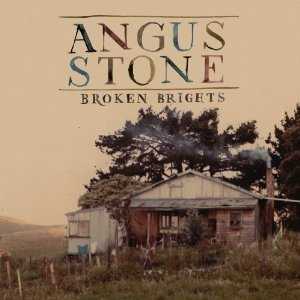 For the uninitiated, Angus Stone is one half of Australian brother-sister folk duo, Angus and Julia Stone. While his first solo album, ‘Smoking Gun‘, was released under the moniker Lady of the Sunshine, this time his name is proudly emblazoned on the front.
For the uninitiated, Angus Stone is one half of Australian brother-sister folk duo, Angus and Julia Stone. While his first solo album, ‘Smoking Gun‘, was released under the moniker Lady of the Sunshine, this time his name is proudly emblazoned on the front.
From that alone, one can assume ‘Broken Brights‘ is more than just a few songs Stone had lying around.
Solo records are often bold declarations of musical freedom and discovery. That can lead to inspired work, as the artist in question breaks from the shackles of overbearing and over-conservative band mates. But it can also mean quality control is thrown out the studio door with the removal of the last barrier between questionable material and the public.
On ‘Broken Brights’, Stone experiences the pros and the perils of being on his lonesome. Still, anyone expecting a wild departure from earlier work will be disappointed. One glance at the cover – its colour palette spans different earthy shades of brown, say from The Band to Harvest– would be enough to know Broken Brights is rooted in Stone’s usual earnest folkisms. Indeed, the thirteen songs on ‘Broken Brights’ are what you’d expect – well written, melodic folk songs.
So what’s different this time around? Well, without his older sister beside him, Stone is more eager to let his blues and rock influences come to the fore. He spends far more time with his foot on the overdrive pedal than usual and in doing so, reveals himself to be a talented guitar player. He’s also happy to wear his influences proudly on his sleeve. In fact, for better or worse, ‘Broken Brights’ is quite transparent in its reverence to Stone’s heroes.
First single ‘Bird On A Buffalo‘ is a case in point. It’s also one of the album’s finer moments, striking the perfect balance between homage and imitation. It begins as a simple acoustic strum, recalling Angus and Julia’s beautiful early singles ‘Just A Boy‘ and ‘Silver Coin‘, but as Stone channels Neil Young at his most visceral, the song is quickly turned on its head. Stone kisses the sky at every opportunity, his squealing solos filling the gaps with aplomb. Topping things off is a gorgeous vocal performance and a memorable off-beat melody. ‘Bird On A Buffalo’ is simply one of Stone’s best songs, solo or otherwise.
Similarly excellent is the title track, an enthralling, folky take on slowcore. Its fragile melody is complemented by an understated lead guitar line and 4×4 schoolboy percussion. ‘Wooden Chair‘ features handclaps, whistling, and shout outs of “hey” set to a stolid acoustic guitar. Stone sings in an unusually clear voice about being “in love”. Meanwhile, further down, ‘Monsters‘ is a reflective banjo number about and includes a tasteful horn interlude.
The album’s centrepiece, ‘Only A Woman‘, is also a highlight as Stone remembers an encounter with a mysterious, unnamed girl. “Takes me back to that first time/ I reach for words that just weren’t there/ our next touch came the moonshine, upon our skin so bare.” The layered guitars provide the perfect backdrop for a double tracked vocal, while the piano solo is a clever twist on what is otherwise the most guitar driven song on the record. It’s also another Neil Young tribute, with searing licks splayed all over the place. The coda is particularly affecting as Stone strangles the neck of his guitar with rare aggression. If this were still the era of vinyl, it would make the perfect closer to side one.
But things don’t always turn out so well. ‘It Was Blue‘ takes its cues (and chords) from ‘I Wanna Be Your Dog‘ but lacks of The Stooges‘ ferocity. Instead it plods along impotently with Stone’s Iggy-aping howls proving cartoonish at best. Similarly disappointing is ‘Apprentice of the Rocket Man‘. The spacey synth sounds are jarring and fail to hide the song’s distinct averageness. A little better is the spaghetti western shuffle of ‘Blue Door‘, though it’s still more filler than killer.
‘Be What You Be‘ is a beautiful Paul Simon homage, with the oft-repeated “be what you be” refrain being utterly infectious, and its African rhythms downright refreshing. The optimistic vocal exudes an almost childlike sense of wonder. It’s easily the album’s most enjoyable moment, and a song you imagine was as fun to record as it is to listen to. In a perfect world, ‘Broken Brights’ would’ve ended here.
But of course, it doesn’t. Penultimate track, ‘Clouds Above‘ aims for dreamy Beatles-eque balladry but never arrives. There are more horns, but few new ideas or redeeming qualities. It’s also the shortest song on ‘Broken Brights’ at just under three minutes – three minutes that could’ve easily been shaved off the album, you might say. The album’s closer remains on the Beatles trip but is no less disappointing.
Sadly, with a little quality control, this could’ve been a great record. But solo records are rarely about restraint or focus. ‘Broken Brights’ is no different.
There’s enough here to suggest Stone may one day make a classic album to rival the ones in his own record collection, but ‘Broken Brights’ just isn’t it.


